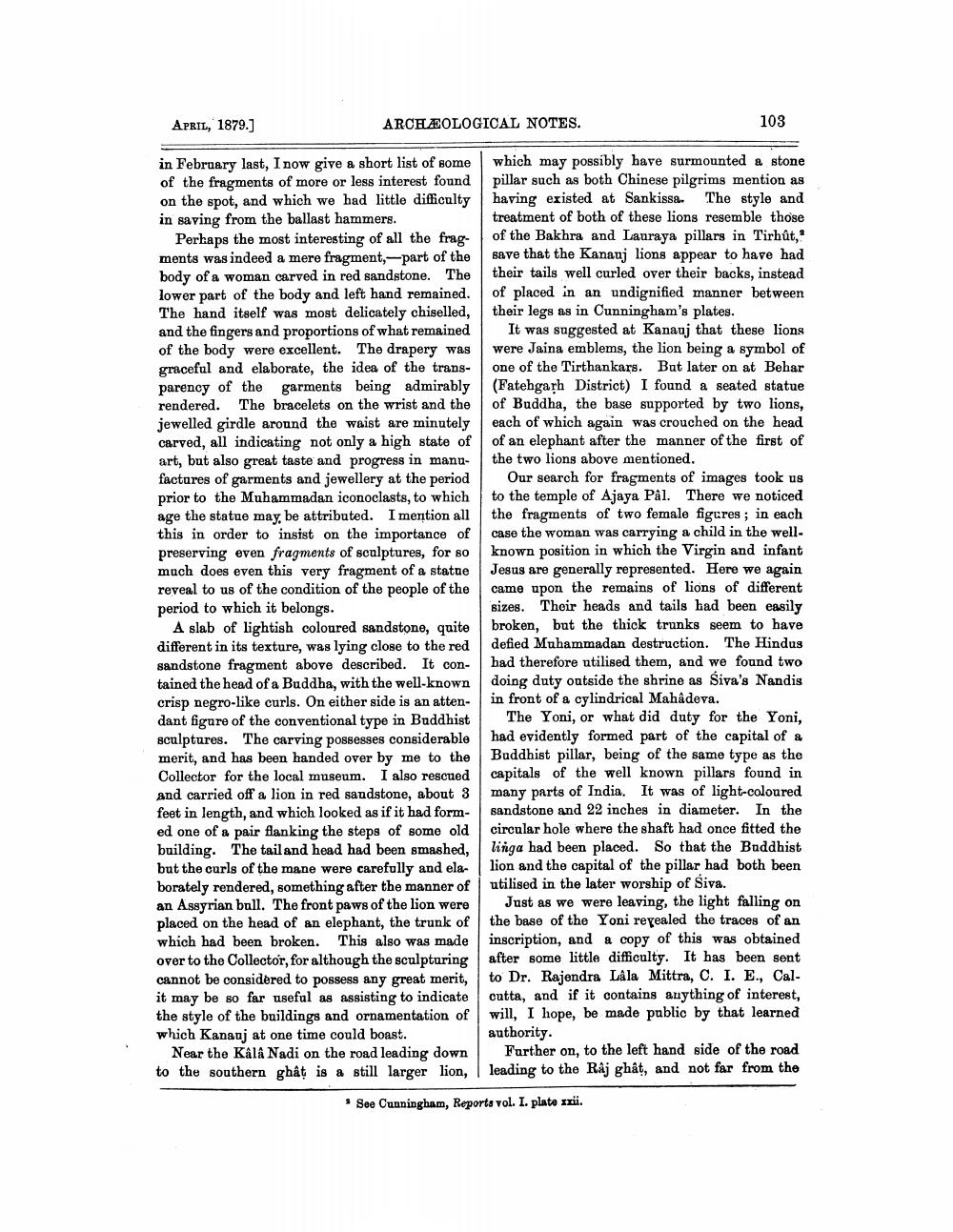________________
APRIL, 1879.]
ARCHÆOLOGICAL NOTES.
103
in February last, I now give a short list of some which may possibly have surmounted a stone of the fragments of more or less interest found pillar such as both Chinese pilgrims mention as on the spot, and which we had little difficulty having existed at Sankissa. The style and in saving from the ballast hammers.
treatment of both of these lions resemble those Perhaps the most interesting of all the frag- of the Bakhra and Lauraya pillars in Tirhût, ments was indeed a mere fragment, part of the save that the Kananj lions appear to have had body of a woman carved in red sandstone. The their tails well curled over their backs, instead lower part of the body and left hand remained. of placed in an undignified manner between The hand itself was most delicately chiselled, their legs as in Cunningham's plates. and the fingers and proportions of what remained It was suggested at Kanauj that these lions of the body were excellent. The drapery was were Jaina emblems, the lion being a symbol of graceful and elaborate, the idea of the trans- one of the Tirthankars. But later on at Behar parency of the garments being admirably (Fatehgarh District) I found a seated statue rendered. The bracelets on the wrist and the of Buddha, the base supported by two lions, jewelled girdle around the waist are minutely each of which again was crouched on the head carved, all indicating not only a high state of of an elephant after the manner of the first of art, but also great taste and progress in manu- the two lions above mentioned. factures of garments and jewellery at the period Our search for fragments of images took us prior to the Muhammadan iconoclasts, to which to the temple of Ajaya Pål. There we noticed age the statue may be attributed. I mention all the fragments of two female figures; in each this in order to insist on the importance of case the woman was carrying a child in the wellpreserving even fragments of sculptures, for so known position in which the Virgin and infant much does even this very fragment of a statue Jesus are generally represented. Here we again reveal to us of the condition of the people of the came upon the remains of lions of different period to which it belongs.
sizes. Their heads and tails had been easily A slab of lightish coloured sandstone, quite broken, but the thick trunks seem to have different in its texture, was lying close to the red defied Muhammadan destruction. The Hindus sandstone fragment above described. It con- had therefore utilised them, and we found two tained the head of a Buddha, with the well-known doing duty outside the shrine as Siva's Nandis crisp negro-like curls. On either side is an atten- in front of a cylindrical Mahadeva. dant figure of the conventional type in Buddhist The Yoni, or what did duty for the Yoni, sculptures. The carving possesses considerable
had evidently formed part of the capital of a merit, and has been handed over by me to the Buddhist pillar, being of the same type as the Collector for the local museum. I also rescued capitals of the well known pillars found in and carried off a lion in red sandstone, about 3 many parts of India. It was of light-coloured feet in length, and which looked as if it had form- sandstone and 22 inches in diameter. In the ed one of a pair flanking the steps of some old circular hole where the shaft had once fitted the building. The tail and head had been smashed, linga had been placed. So that the Buddhist but the curls of the mane were carefully and ela- | lion and the capital of the pillar had both been borately rendered, something after the manner of utilised in the later worship of Siva. an Assyrian bull. The front paws of the lion were
Just as we were leaving, the light falling on placed on the head of an elephant, the trunk of the base of the Yoni revealed the traces of an which had been broken. This also was made inscription, and a copy of this was obtained over to the Collector, for although the sculpturing after some little difficulty. It has been sent cannot be considered to possess any great merit, to Dr. Rajendra Lala Mittra, C. I. E., Calit may be so far useful as assisting to indicate cutta, and if it contains anything of interest, the style of the buildings and ornamentation of will, I hope, be made public by that learned which Kananj at one time could boast.
authority. Near the Kâlâ Nadi on the road leading down Further on, to the left hand side of the road to the southern ghat is a still larger lion, leading to the Raj ghat, and not far from the
* See Cunningham, Reports vol. I. plate xxii.




